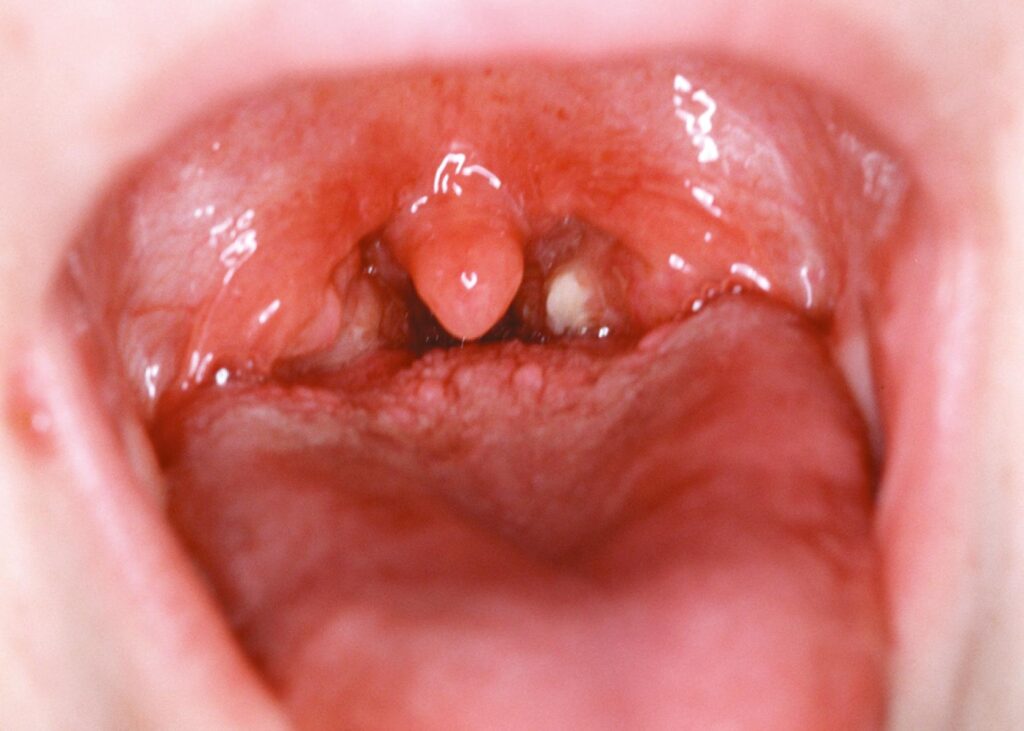Pharyngitis Due to Streptococcus pyogenes: Pharyngitis caused by Streptococcus pyogenes, also known as Group A Streptococcus (GAS), represents one of the most common and clinically significant bacterial throat infections. Prompt diagnosis and treatment are essential to reduce symptoms, prevent complications, and limit transmission.

Understanding Streptococcus pyogenes and Its Pathogenic Role
Streptococcus pyogenes is a gram-positive, beta-hemolytic bacterium known for its rapid transmission and potential to cause severe complications if untreated. It primarily affects the pharynx and tonsils, triggering a robust inflammatory response.
Transmission Mechanism and Pathogenesis
The bacteria spread through respiratory droplets or direct contact with infected individuals. Once adhered to epithelial cells, it evades immune response through its M protein, streptolysins, and hyaluronic acid capsule, leading to acute pharyngeal inflammation.
Epidemiology and Risk Groups
Pharyngitis due to S. pyogenes is most prevalent among children aged 5–15 but can affect individuals of any age. Outbreaks are more frequent during winter and early spring in densely populated settings such as schools and daycare centers.
High-risk groups include:
- School-aged children
- Immunocompromised individuals
- Residents of communal living facilities
- Healthcare workers in pediatric or ENT settings
Clinical Manifestations of Streptococcal Pharyngitis
Onset is abrupt, typically 2–5 days after exposure. The clinical picture often includes:
- Sudden severe sore throat
- Painful swallowing (odynophagia)
- Fever ≥38.5°C (101.3°F)
- Red, swollen tonsils with white exudate
- Tender anterior cervical lymphadenopathy
- Headache and malaise
- Scarlatiniform rash (in scarlet fever cases)
Notable Absences:
- Cough, runny nose, hoarseness, and conjunctivitis—these features suggest a viral etiology.
Diagnostic Evaluation
A combination of clinical scoring and laboratory confirmation ensures diagnostic accuracy.
Centor Criteria (Modified)
Used to estimate the likelihood of streptococcal infection:
- Tonsillar exudates (+1)
- Tender anterior cervical nodes (+1)
- Fever (+1)
- Absence of cough (+1)
- Age 3–14 years (+1); 15–44 years (0); ≥45 years (–1)
Laboratory Tests
- Rapid Antigen Detection Test (RADT):
- High specificity (~95%), moderate sensitivity (~70–90%)
- Immediate results within minutes
- Throat Culture:
- Gold standard with ~90–95% sensitivity
- Results within 24–48 hours
- Required when RADT is negative in children but suspicion remains high
- Polymerase Chain Reaction (PCR):
- Highly sensitive and specific
- Detects bacterial DNA directly
Treatment Guidelines for S. pyogenes Pharyngitis
Timely antibiotic therapy alleviates symptoms, shortens disease course, and prevents complications such as rheumatic fever.
First-Line Antibiotics
- Penicillin V: 250 mg orally 2–3 times daily for 10 days (children); 500 mg twice daily (adults)
- Amoxicillin: Often preferred for better palatability in children
Alternatives for Penicillin Allergy
- Cephalexin (if non-anaphylactic reaction)
- Clindamycin or Azithromycin for macrolide-sensitive strains
Adjunctive Measures
- Analgesics: Acetaminophen or ibuprofen
- Saltwater gargles
- Adequate hydration
- Rest and vocal conservation
Complications of Untreated Streptococcal Pharyngitis
Failure to treat streptococcal pharyngitis can lead to both suppurative and non-suppurative complications.
Suppurative Complications
- Peritonsillar abscess
- Retropharyngeal abscess
- Otitis media
- Sinusitis
Non-Suppurative Complications
- Acute rheumatic fever
- Post-streptococcal glomerulonephritis
- Scarlet fever
- Pediatric autoimmune neuropsychiatric disorders associated with streptococcal infections (PANDAS)
Prevention Strategies and Public Health Considerations
Preventive Measures
- Avoid close contact with infected individuals
- Frequent handwashing
- Cover mouth and nose when coughing/sneezing
- Disinfect commonly touched surfaces
Infection Control
- Patients are considered non-infectious after 24 hours of appropriate antibiotic therapy
- Children may return to school 24 hours after starting antibiotics and being afebrile
Differential Diagnosis
| Condition | Key Differentiators |
|---|---|
| Viral pharyngitis | Cough, nasal congestion, conjunctivitis |
| Infectious mononucleosis | Generalized lymphadenopathy, splenomegaly, fatigue |
| Diphtheria | Grey membrane, low-grade fever, toxic appearance |
| Herpangina (enteroviruses) | Vesicular lesions on soft palate |
Frequently Asked Questions:
How long is streptococcal pharyngitis contagious?
Contagious for up to 2–3 weeks without treatment, but typically no longer infectious after 24 hours of antibiotic therapy.
Can streptococcal pharyngitis resolve on its own?
Yes, in some cases. However, antibiotics are essential to prevent complications like rheumatic fever.
Should household contacts be tested?
Only if symptomatic. Asymptomatic carriers usually do not require treatment unless in outbreak situations.
Can you get strep throat more than once?
Yes. Immunity is type-specific, and reinfection with different strains is possible.
Pharyngitis due to Streptococcus pyogenes remains a critical public health concern requiring vigilant clinical assessment and timely intervention. Accurate diagnosis using a combination of clinical criteria and laboratory tests, followed by appropriate antibiotic therapy, not only ensures symptomatic relief but also mitigates the risk of severe systemic complications. Maintaining infection control protocols and educating at-risk populations further supports effective disease management.